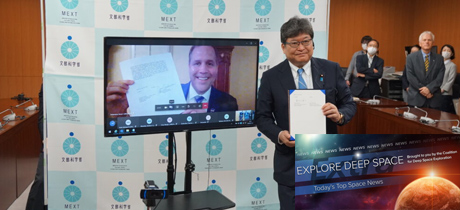In Today’s Deep Space Extra… NASA and Japan’s Ministry of Education, Culture, Sports, Science and Technology Thursday expressed their intent for further cooperation in the human exploration of space. Debate over NASA’s 2021 budget continues. NASA also unveiled an unfolding strategy to deal with planetary protection, efforts to prevent the contamination of planetary bodies with Earthly life forms and, as well as contamination of the Earth with extraterrestrial microbes.
Human Space Exploration
NASA and Japan sign “JEDI” declaration on future space cooperation
Spacepolicyonline.com (7/9): A new Joint Declaration of Intent between NASA and Japan’s Ministry of Education, Culture, Sports, Science and Technology, which oversees the Japan Aerospace Exploration Agency, expresses plans by the two countries to expand their cooperation on the International Space Station (ISS) toward future exploration of the Moon. Though it does not spell out specific commitments, Japan has expressed desires to participate in a NASA led, lunar orbiting Gateway, and a multinational spacecraft that would serve as a permanent command module for astronauts arriving from Earth and traveling to and from the surface of the Moon. Potential roles for Japan include a habitation module and a pressurized rover for traversing the lunar surface. Similar discussions are underway between NASA and other international space agencies.
House Republicans criticize NASA spending bill
SpaceNews.com (7/9): Republicans in the U.S. House are concerned over insufficient support among fellow appropriators for NASA’s human deep space exploration agenda. On Wednesday, the House Appropriations Commerce, Justice and Science subcommittee backed a 2021 NASA appropriations measure equal to the agency’s 2020 budget, but less than the $25.2 billion requested in order to develop and test the hardware needed to return human explorers to the surface of the Moon in 2024. During a Wednesday markup, Democrat and Republican members of the House Appropriations Commerce, Justice and Science subcommittee were divided on whether the measure was adequately addressing NASA’s space priorities.
NASA is updating its guidelines on how to prevent contamination of the Solar System
The Verge (7/9): NASA on Thursday unveiled new evolvable strategies to address planetary protection concerns as it develops plans for the return of human explorers to the surface of the Moon in 2024 and on to Mars in the decade that follows. The strategies address concerns that human microbes could contaminate the two planetary destinations and that human explorers could return to Earth with harmful bacteria and viruses. Different regions of individual planetary bodies, for instance Mars, will likely be assessed differently, meaning some regions may require more protective measures than others.
Can astronauts be allergic to moon dust? NASA seeks an answer
Houston Chronicle (7/9): NASA scientists are using samples of the Moon gathered by the Apollo astronauts between 1969 and 1972 to study whether lunar dust could become a health issue for human explorers assigned to return to the Moon in 2024 and establish a sustainable human presence by 2024.
For the first time in eight years, a Russian woman will fly to the ISS. Who is she?
Russia Beyond the Headlines (7/9): As 2022 draws to a close, Russia plans to launch a female cosmonaut, Anna Kikina, to the International Space Station (ISS). She’s the first woman cosmonaut slated to launch since Elena Serova, who lived and worked aboard the space station in 2014/15. Kikina is trained in engineering, economics and journalism.
Space Science
Mars rover mated with Atlas 5 launcher after teams deal with coronavirus cases
Coalition Member in the News – United Launch Alliance
Spaceflightnow.com (7/9): NASA’s Perseverance Mars 2020 rover has been stacked atop a United Launch Alliance (ULA) Atlas 5 rocket at Cape Canaveral Air Force Station (CCAFS), Florida, for a planned July 30 launch to Mars and a mission to assess the habitability of Jezero Crater, site of an ancient lake and stream delta, and to gather and cache rock and soil samples for return to Earth on a future mission. Workers have repaired a small leak in the rocket and overcome workplace constraints imposed to deal with the coronavirus pandemic.
With first spacecraft to Red Planet, United Arab Emirates poised to join elite Mars club
Science Magazine (7/8): The United Arab Emirates (UAE) intends to join a small circle of nations that have explored Mars, with the July 15 launch of Hope, an orbiter developed to study the Martian atmosphere and climate and a mission intended to encourage new domestic industrial and scientific activity. Launching from Japan, Hope is to reach Mars in February. NASA and China are also launching missions to Mars this month, when the Earth and Mars are favorably aligned for the journey.
Other News
High-throughput communications satellite launched from China
Spaceflightnow.com (7/9): On Thursday, China logged the successful launch of a Long March 3B rocket with a high-power broadband communications satellite designed to provide Internet access to airliner passengers, cruise ships, fishing vessels, and other mobile users.
China’s Kuaizhou-11 carrier rocket fails in maiden flight
Xinuanet, of China (7/9): The launch of China’s new Kuaizhou-11 rocket from the Jiuquan Satellite Launch Center ended in failure on Friday.

